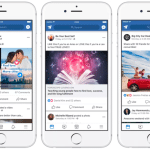It’s not a surprise that Facebook is the dominant social platform. That was one of the conclusions from the 3rd annual RBC Capital Markets study of 5,000 U.S. Internet users. There were surprises, though. One of them was the satisfaction rates of the various platforms (Facebook could do better here). Another surprise (well, not really) was the dominant showing of Snapchat with children and teens.
Social Media & SEO


Link Authority Tops List of Most Important Google Ranking Factors
January 9th, 2018 by Seth ArensteinOne of the holy grails of PR must be the definitive word on Google’s SEO regime. While that might be unattainable we can make educated guesses as to how the search giant ranks articles. Branded3 of the U.K. has issued its list of best guesses as well as a list of things that can be done to a site and its contents to improve searchability ranking.

Investors Urge Apple to Consider Dangers of Youth Phone Usage Yet Adults Are Addicted Too
January 9th, 2018 by Seth ArensteinMany of us believe we know all about activist investors. A pair of investors threw a curveball last weekend, urging that Apple seriously consider warning parents about the dangers of excessive iPhone use for children and teens. Their demands were well crafted and included a bevy of studies and statistics.
Few Consider the Potential Risks of Influencers [VIDEO]
January 8th, 2018 by Seth ArensteinAs we know, there is a lot of enthusiasm for engaging with influencers on social media. Yet few communicators spend time strategizing about possible risks, says Emma Monks, head of trust & safety at Crisp Thinking.… Continued
Things Are Looking Up for Communicators (A Note to PR News Readers)
January 8th, 2018 by Diane SchwartzThere’s a line in the movie “Molly’s Game” I think you’ll appreciate. As the young and future Olympic-level skier Molly Bloom was learning the sport from her father, he gave her this advice on the… Continued

Outrage From Logan Paul Video and Trump’s Nuclear Tweets Puts Social Platforms on the Alert
January 3rd, 2018 by Seth ArensteinIt is said there are two sides to every story. Similarly the internet and social media platforms have their pros and cons, although the net’s bad characteristics often receive the dominant share of attention. 2018 might mark a consensus around a new code of conduct for social media as several breaking stories seem to demonstrate.
Outrage From Logan Paul Video and Trump’s Nuclear Tweets Puts Social Platforms on the Alert
January 3rd, 2018 by Seth ArensteinWe’ve heard it said often at conferences and during panels at trade shows: “The internet and social media have their good sides and bad sides.” While it’s true that what many consider the bad side… Continued

Consumer Engagement with B2B Brands in 2017 Holds Steady vs 2016, IMG Models Tops List
December 19th, 2017 by Seth ArensteinAs the year ends with this edition of PR News , we begin the first of three data installments provided exclusively to us by data partner Shareablee. In this first edition Shareablee provides the most-engaged B2B brands during 11 months of the year with Facebook, Twitter and Instagram.

Facebook Puts the Smack Down on Posts That Ask for Likes or Shares
December 18th, 2017 by Jerry AsciertoStarting today, Facebook will demote what it calls “engagement bait,” posts that lure users into interaction by explicitly asking for likes and shares without offering editorial value. The posts are one way that brands can take advantage of Facebook’s (ever more discriminating) News Feed algorithm by boosting engagement to gain more organic reach. But the platform is taking action in response to widespread complaints, likely forcing some brands to rethink their approach.

3 Ways Netflix’s ‘Prince’ Tweet Dampened the Christmas Spirit
December 12th, 2017 by Sophie MaerowitzWhen it comes to holiday tweets, should brands play naughty or nice? Netflix’s snarky tweet, calling out fans of its program “A Christmas Prince,” begged the question. In a statement to PR News, Netflix wrote: “The privacy of our members’ viewing is important to us. This information represents overall viewing trends, not the personal viewing information of specific, identified individuals.”


